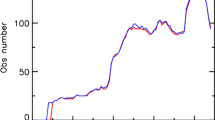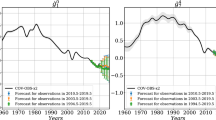Abstract
Both magnetospheric and solid Earth geophysicists often employ two-dimensional arrays of recording variometers to reconstruct the spatial distribution of transient magnetic field variations at the Earth's surface. These discrete data are typically interpolated over a dense grid and the results, for example, are contoured. Few studies, however, have explored the efficacy of employing various polynomial forms for interpolating the same data set, nor have they examined how regional polynomial forms relate to magnetic variation sources on a global scale. The present study addresses some of these concerns. We quantify the characteristics of various smoothed models (i.e., low-order polynomial trend surfaces) for the same data set from a subglobal network of magnetic variometers. Using a relatively quiet interval of undisturbed diurnal variation, we characterize the spatial distribution of the three individual magnetic vector components at a single instant of time—or for what we call a ‘time slice’. We then explore how our model functions are affected by the presence or absence of various site data, i.e., what is the ‘information content’ of a particular site in our array and how important is it to constraining the final smooth model function that we derive? Finally, we explore how such local model functions are affected by including data from outside the array by studying the relation between our local polynomial forms and the global source fields from which they derive.
Similar content being viewed by others
References
Akima, H. (1978),A method of bivariate interpolation and smooth surface fitting for irregularly distributed data points. ACM Trans. Math. Software4, 148–159.
Alldredge, L. R. (1982),Geomagnetic local and regional harmonic analyses. Jour. Geophys. Res.87, 1921–1926.
Draper, N. R. andSmith, H. (1981),Applied Regression Analysis. John Wiley & Sons, New York.
Frazer, M. C. (1974),Geomagnetic deep sounding with arrays of magnetometers. Rev. Geophys. Space Phys.12, 401–420.
Fulker, D. (1973),NCAR software. National Center for Atmospheric Research, P.O. Box 3000, Boulder, CO, 80307.
Gough, D. I. andIngham, M. R. (1983),Interpretation methods for magnetometer arrays. Rev. Geophys. Space Phys.21, 805–827.
Imsl. (1982),Computer subroutine libraries in mathematics and statistics (library contents). International Mathematical and Statistical Libraries Inc., Sixth Floor, GNB Bldg., 7500 Bellaire Blvd., Houston, TX, 77036.
Ingham, M. R., Bingham, D. K. andGough, D. I. (1983),A magnetovariational study of a geothermal anomaly. Geophys. J. Roy. Astr. Soc.72, 597–618.
Jackson, D. D. (1972),Interpretation of inaccurate, insufficient, and inconsistent data. Geophys. J. Roy. Astro. Soc.28, 97–109.
Jones, A. G. (1980),Geomagnetic induction studies in Scandinavia. J. Geophys.48, 181–194.
Kuppers, F., Untiedt, J., Baumjohann, W., Lange, K. andJones, A. G. (1979),A two-dimensional magnetometer array for ground-based observations of auroral zone electric currents during the International Magnetospheric Study (IMS). J. Geophys.46, 429–450.
Lilley, F. E. M., Woods, D. V. andSloan, M. N. (1981),Electrical conductivity from Australian magnetometer arrays using spatial gradient data. Phys. Earth Planet. Int.25, 202–209.
Matsushita, S. (1983),Cautions for the estimation of equivalent current systems from geomagnetic data. Planet. Space Sci.31, 1199–1208).
Mellushi, R. K. (1931),An Introduction of the Mathematics of Map Projections. Cambridge University, Cambridge.
Nakagawa, I. andYukutake, T. (1985),Rectangular harmonic analyses of geomagnetic anomalies derived from MAGSAT data over the area of the Japanese Islands. J. Geomag. Geoelectr.37, 957–977.
Prenter, P. M. (1975),Splines and Variational Methods. John Wiley & Sons, New York.
Richmond, A. D. andBaumjohann, W. (1983),Three-dimensional analysis of magnetometer array data. J. Geophys.54, 138–156.
Winch, D. E. (1981),Spherical harmonic analysis of geomagnetic tides, 1964–1965. Phil Trans. Roy. Soc. Lond. Ser.A 303, 1–104.
Woods, D. V. andLilley, F. E. M. (1979),Geomagnetic induction in Central Australia. J. Geomag. Geoelectr.31, 449–458.
Author information
Authors and Affiliations
Rights and permissions
About this article
Cite this article
Rossen, M.L., Hermance, J.F. Polynomial smoothing of quiet-time magnetic variations for an irregularly spaced array of sites. PAGEOPH 125, 41–65 (1987). https://doi.org/10.1007/BF00878613
Received:
Revised:
Accepted:
Issue Date:
DOI: https://doi.org/10.1007/BF00878613




